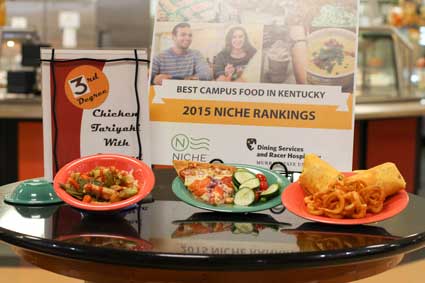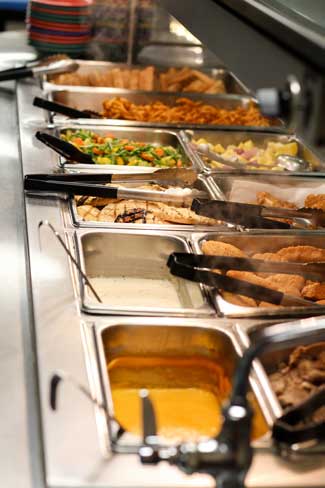Story by Courtney Scoby, Staff writer

Winslow Dining Hall and Thoroughbred Room are making extra efforts to reduce the amount of food wasted.
Winslow Dining Hall. It’s where we meet friends for a leisurely brunch on the weekends, stuff ourselves with every fried food imaginable late at night while we prepare for all-nighters and where we grab takeout on super-busy days.
We aren’t the only busy ones though. The cooks and servers at all of the on-campus dining facilities are constantly moving too, preparing made-to-order chicken wraps, replenishing quickly depleted french fry bins, and doling out massive quantities of food very quickly.
One of the things they aren’t doing is wasting food.
“To be able to provide the variety that the customers want along with the quality that is expected there will always be waste,” Kelly Buckingham, manager of the Thoroughbred Room and Market ’22 said. “But keeping it minimal is the key.”
Because the on-campus dining facilities feed so many students each day, it can be difficult to manage and predict food waste, but Dining Services uses several strategies to prevent food waste.
FOOD WASTE TECHNOLOGY
“We have technology that provides production reports and information on exactly how many of any given item is sold in our cash operations,” Paula Amols, director of Dining Services said. “That information is used to adjust both production and purchasing as needed.”
In addition, the T-Room uses an even more sophisticated technology to prevent food waste, the LeanPath Waste Management System.
Small scraps of food waste are collected throughout the day, along with all unusable product that is left over at the end of the day and put into the machine, which weighs the waste.
“What we look at is if the waste has been reduced,” Buckingham said. “We look at high waste areas and will implement a program to reduce the waste.”

“Just in time cooking” is a strategy used by dining services to reduce the amount of food wasted.
Many other low-tech strategies are used to prevent food waste on campus as well.
“Sometimes sharing with each venue reduces possible waste,” Buckingham said.
For example, the T-Room and Market ’22 often share unused, but still usable salad bar items in order to avoid throwing away perfectly fresh food.
Incorporating extra food into other dishes is a common practice in on-campus dining facilities.
Preventing food waste “is a bigger challenge at Winslow because of the larger volume of food they handle, and the large variety of items they serve,” Amols said. “But, that also provides more opportunities/places to use any extra food.”
Tim Bruce, executive chef and manager at Winslow Dining Hall said that one of the most helpful strategies was “keeping certain items componentized as long as you can.”
This practice involves keeping ingredients separate as long as possible so large amounts of complete dishes are not cooked if they are not needed.
For example, Bruce said that the ingredients of a broccoli chicken casserole would be kept separate until needed. A large amount of the food is cooked at the beginning of the day, but “as you get later in the day, we should just be making two pans at a time,” he said. “And at the end of the day we end up with an extra case of broccoli cut, but we’ve just got pure florets that can end up as a fresh vegetable.”
This is part of a larger strategy, called “just in time cooking,” used in all campus dining facilities.
‘JUST IN TIME’ COOKING:
“Just in time cooking” involves cooking large amounts of food at the start of the day, but not enough to feed all of the students forecast to come that day. Additional smaller batches are cooked throughout the day as they are needed.
“So as you get through the day, through the rush, you have plenty of food, but at the slower time of day, where people are just kind of trickling in between lunch and dinner, there’s only a few made of each [main item],” Bruce said.
The goal is to have under a pan of each main item left over after each meal. While these leftover main items will have to be thrown away if they are complete dishes that cannot be saved later or used in another dish, this amount of waste is quite small for such a large dining facility.
“When you’re feeding 500 or 600 [a day], having 10 leftover is not bad,” Bruce said.
However, leftover food is often incorporated into different dishes so less is wasted.
“If we’re doing our job right, there’s not a ton of [leftovers],” Bruce said. “[But] we don’t throw anything usable away. Most of the time we rework it. If we have chicken left over, we’re not going to have the same chicken dish.”
A lot of the time, food can be saved as is to be used later.
“We normally make lasagna in batches of about 35 at a time,” Bruce said. “[If] we have five or ten left over that are uncooked, we’ll wrap and freeze them for the next time lasagna comes up on the menu.”
For the most part though, very little food is thrown away at the end of the day.
“The only food that gets thrown out is food that has been sitting out past a certain length of time or is otherwise not in a condition to be safely reused in some manner,” Amols said.
The Students’ Side
When it comes to limiting food waste, students can do their part as well.
“The amount of food that comes from the dish return can sometimes be surprising,” Buckingham said. “Customers’ eyes are sometimes bigger than their stomachs.”
Students can help prevent food waste by not taking more food than they can consume and using takeout containers to save excess food for later.
Rest assured, dining services takes food waste very seriously.
“Food waste is a horrible thing,” Bruce said. “From a businessman’s point of view, it hurts our costs, it hurts our numbers, on top of the actual moral implications of wasting food.”
While Dining Services works very hard to reduce food waste, they are always looking for new ways to limit food waste.
“We have good production practices in place to keep it to as much of a minimum as possible,” Amols said. “That doesn’t mean I think there’s not room for improvement.”